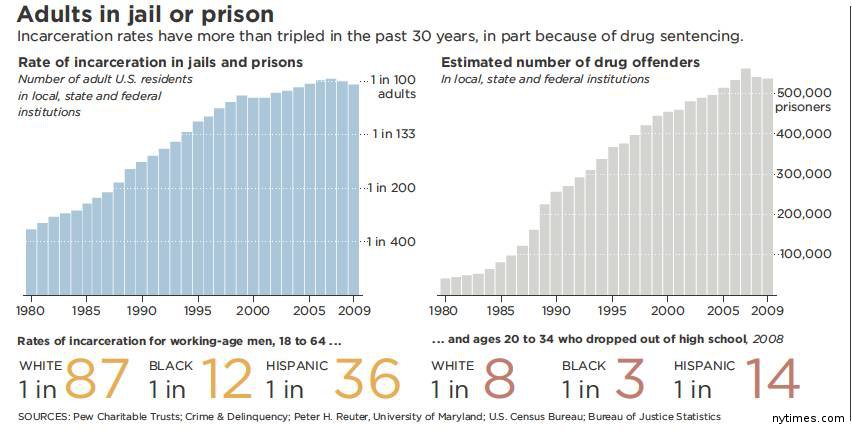THE DRUG WAR: A RECORD OF FAILURE
The drug war does NOT include education, prevention and treatment. It has detracted from their effective use.
See: Drug War Defined
Unless the public grasps the depths of the failure of the drug war they may be inclined to believe that it at least stops the problem from getting worse and tolerate the absence of debate about alternatives.
The drug war is like a Rain Dance in many respects. It deals with a serious problem, but does nothing to reduce the problem. It's driven by good intentions, wishful thinking and superstition, not by results and science. It's a costly illusion used to pacify the public.
* The drug war does not limit supply or availability. It has made drugs more available to the young. Stopping supply is impossible.
See: Supply
* Laws and punishment do not deter use or abuse.
See: Deter
* Laws and punishment do not deter the presence of drug dealers. The drug war multiplies their numbers and influence, tempting children to join their ranks. [1]
* Prohibition makes already dangerous drugs much more dangerous. It makes them more potent and less predictable. [2]
* Prohibition multiplies the harm done to the public by drug abuse and to the abusers themselves. [3]
* Official spokesman have distorted objective measurements to make false claims of success. [4]
On a balance sheet, the drug war's positive contributions must be recorded as negligible to non-existent. Worse yet, its unintended consequences have done enormous damage to society.
See: Drug War Damage
The problem is magnified by the insulation of the drug war from criticism. When a leading drug war supporter, Republican Dan Burton, made a remarkable critical speech, it received almost no attention. (For excerpts from the speech, see [5])
Measuring the Failure
In Science we explain why "drug use," especially, "used in the past month," government's most common way of reporting on the drug war, is often a very poor measure. Normally, it's about as useful as measuring rainfall would be to measure the effectiveness of a Rain Dance. Also see False Claims.
There are five primary ways to measure the success or failure of the drug war:
* Willingness to ever break the law and use an illegal drug.
About 62% of our young have tried an illegal drug by age 22. Any number over 30% is close to total failure in practical terms.
The percentage of adults who now admit to using marijuana at some time rose from 31% in 1983 to 47% in 2002.
- Time/CNN poll, Time Magazine, Nov. 4, 2002
* The amount of addiction.
America has the harshest punishments and the highest addiction rates in the free world. There has never even been a government claim of reduced addiction in the past 30 years.
* The size of the drug cartels.
Before prohibition there were no drug cartels.
About 10 years ago, U.N. agencies estimated the annual revenue generated by the illegal drug industry at $400 billion, far more than the entire US national defense budget. An additional estimated $100 billion was made annually from money laundering. They appear to have grown stronger each year since.
For Americans, the symbol of the drug lord is Al Capone. Prohibition turned him from a young punk in his 20's into one of the most powerful, wealthy men in the world with the power to corrupt the police, the judiciary and the electoral process in Chicago. When he went to prison, the illegal alcohol trade continued without missing a beat.
The drug war - modern prohibition - has created the equivalent of a thousand Al Capones and spread them all over the world. We have a lot to answer for.
* The price of the drugs.
" While whisky and beer prices have doubled and cigarettes almost tripled in price over the decade, illegal drugs are now often cheaper than a night out in a pub. The cost of LSD, a hallucinogenic drug, is less than a packet of cigarettes." "The street price of illegal drugs has never been lower. The message should be clear - prohibition has failed."
- from "Drugs - It's all in the price," The Economist, 6-6-02
* The availability of drugs to the young.
Because of their enormous wealth, the cartels have been able to place drugs in or around virtually every school in America. We seem not to have grasped that we are unintentionally funding our own worst enemy.
When the National Center on Addiction and Substance Abuse [CASA] (February 2001) asked teens what drug was "easiest to buy," 33% said MARIJUANA, 10% said BEER.
Additional Measures
Failure has not been for lack of increased effort. The notion that doing the same thing over and over and expecting a different result is the definition of insanity has yet to penetrate most political thinking.
Drug War Spending [Federal Budget Only]
1969 Nixon $ .06 billion
1982 Reagan $ 1.65 billion
1998 Clinton $17.10 billion.
For additional spending information see Basic Facts Chart 2
Prison and Arrests
There are now 12 times as many drug offenders in state prisons as there were in 1980.
Police arrest approximately 1.6 million Americans per year on drug charges, three times as many as they did in 1980.
Results
Purity of the drugs, overdose deaths and emergency room visits are at all time highs.
See www.drugwarfacts.org for additional information

